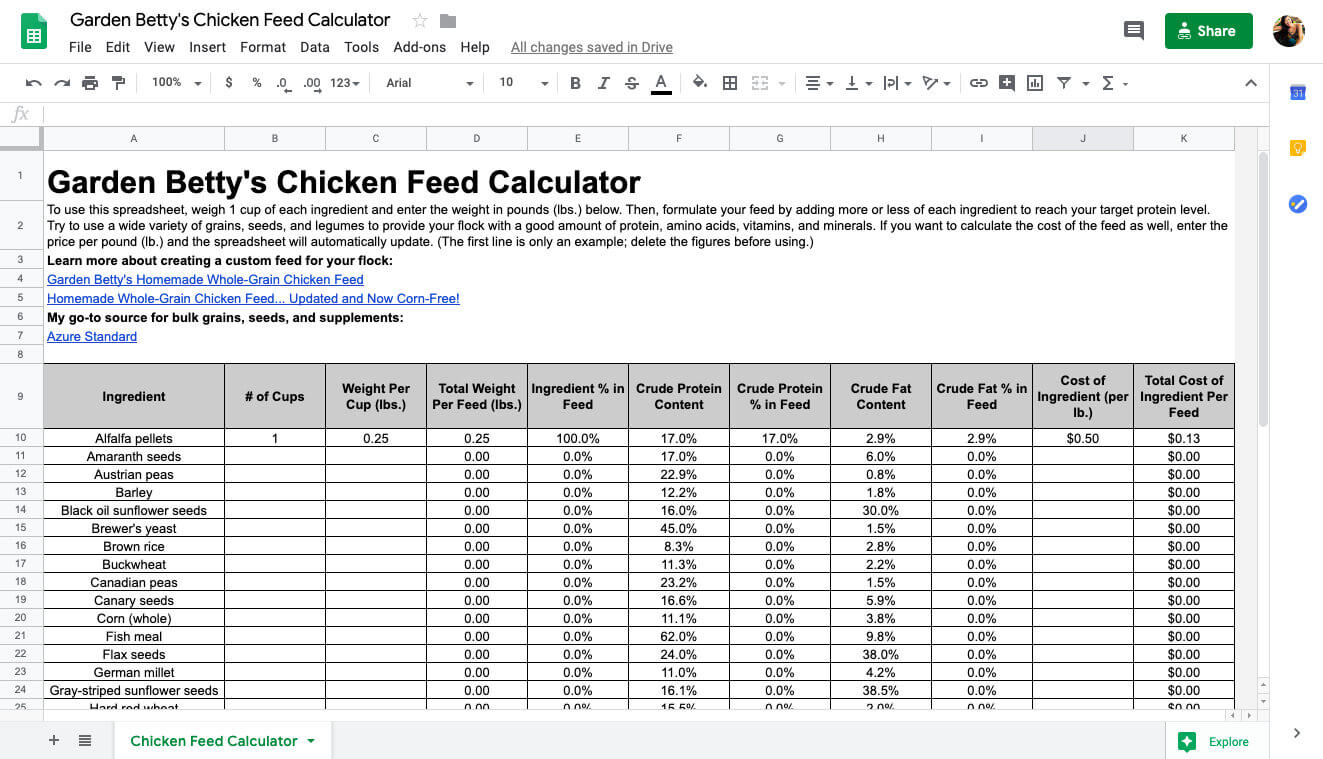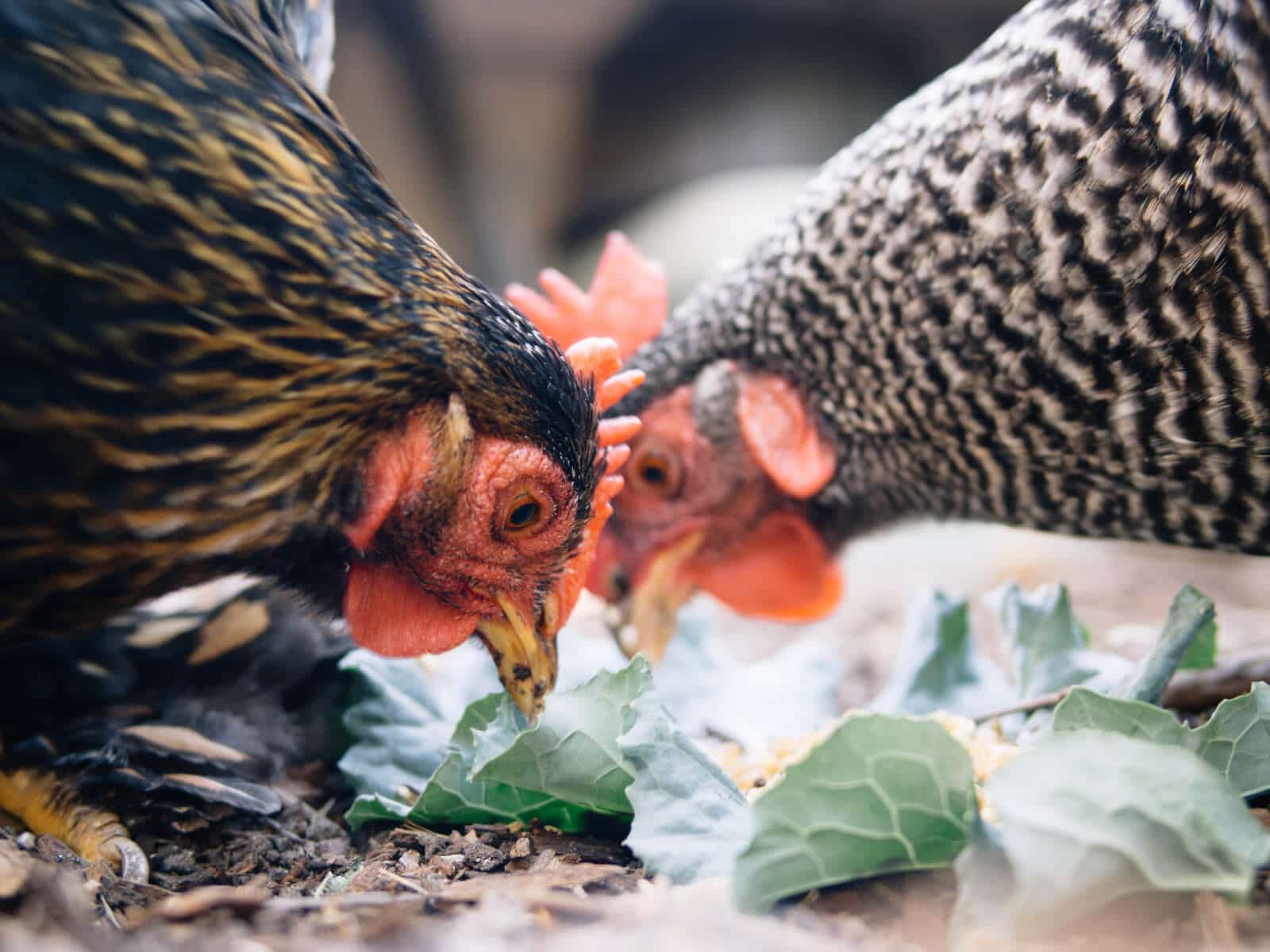If you’ve been following either of my recipes for homemade chicken feed (the original whole-grain feed or the updated corn-free feed), you may have wondered how to calculate the protein content of the recipe should you decide to mix things up.
Perhaps you want to try some other grains and seeds for your flock, or you need to formulate a higher-protein feed for baby chicks, growers, or chickens going through a hard molt.
I personally use a spreadsheet to calculate my figures and manage my costs, and now I’m making this file available to you!

I created this spreadsheet when I first started making my own chicken feed, and still use it from time to time when I reformulate my recipe. (This usually happens in late summer to early fall, when my flock is molting and their nutritional needs change a bit.)
Disclosure: If you shop from my article or make a purchase through one of my links, I may receive commissions on some of the products I recommend.
Garden Betty’s Chicken Feed Calculator works as an Excel (.xlsx) download, so you can save the spreadsheet to your computer, create a custom recipe, and edit the information as needed.
I’ve included a list of common grains, seeds, legumes, and other ingredients that typically make up a poultry feed, along with their crude protein content and crude fat content.
After entering the quantity and weight of each ingredient you use, the total protein will update automatically, allowing you to formulate your feed on the fly.
Weight is the most accurate measure for whole grains, so I recommend investing in a kitchen scale if you haven’t already. This is the one I use.

The amount of protein you should aim for depends on the age of your chickens.
| Age Range | Amount of Protein Required |
| Chick starter (1 to 8 weeks) | 20 to 22 percent protein |
| Grower (8 to 18 weeks) | 16 to 17 percent protein |
| Layer (18 weeks plus, or after the first egg) | 16 to 17 percent protein, plus free-choice oyster shells (for calcium) |
While the recommended ranges are ideal for feeding, they don’t take into account other greens, weeds, seeds, bugs, and treats that your chickens may eat throughout the day, especially if they free-range.

Don’t get too hung up on the number if you’re feeding other things besides grains; a diverse diet is more important than a strict percentage.
I’ve also included a column to calculate the cost of your ingredients. Simply input the price per pound, and the spreadsheet will update with the total cost of your feed. This is especially useful for figuring out if it’s cost-effective to buy certain ingredients.
I buy mine in bulk from Azure Standard, as well as from Amazon (using their free Prime shipping — you can sign up for a 30-day trial here) and my local feed stores.
Keep in mind that the spreadsheet offers a simplistic view of your flock’s nutritional needs. It only determines the protein level of your feed, and doesn’t consider the other crucial components of a diet, such as amino acids, vitamins, and minerals.
Try to use a wide variety of grains, seeds, and legumes (as well as a steady supply of greens and kitchen scraps) to round out your chickens’ feed.
(If you want to learn more, the University of Kentucky Poultry Extension offers excellent information on poultry nutrition.)

The protein and fat content shown for each ingredient are based on nutrition information sourced from my own ingredient labels, as well as typical values listed on cooperative extension sites.
They are not identical across producers (sometimes differing by several points depending on the varieties and growing conditions).
In order to have the most accurate calculation for your custom feed, use the nutrition information from your own packaging, or ask the feed mill from where you source your ingredients.
If you’re adding new ingredients to the spreadsheet but don’t know their nutritional values, a reliable source to check is Self’s Nutrition Data.
Enter the name of your ingredient in the search box, select the appropriate result, change the serving size to 100 grams, and use the figures shown under “Total Fat” and “Protein.” An ingredient listing 1g of fat and 15g of protein will have 1 percent fat and 15 percent protein, for example.
You can download the chicken feed calculator by entering your email address below. (Your email will not be given or sold to third parties. I hate spam, too.)
Happy mixing!
















Just found your sight and what a great spreadsheet – thank you for sharing!
Where did you source your crude protein content and crude fat content percentages from? I’ve looked at a couple of different sites and some of them seem to be quite different from the numbers you’ve populated so I’d like to be consistent.
These numbers can vary because nutritional content is different across manufacturers. The best place to source this information is from the package itself (or from the mill/manufacturer).
Ok, couldn’t get the spreadsheet to work without downloading a program or making a google account, so, I copied everything down on paper and got a calculator.
So, I wanted to get all my ingredients from azure, and the total had to be less than scratch and peck. I came up with:
4 pts unhulled oats @ 12.8% protein and 4% fat
4 pts hard red wheat @ 14.5% protein and 2% fat
4 pts field peas @ 19.5% protein and 1% fat
4 pts soft white wheat @ 9% protein and 2% fat
2 pts rye @ 12.5% protein and 3% fat
2 pts millet @11% protein and 4% fat
2 pts flax @ 24% protein and 38% fat ( I read flax shouldn’t make up more than 10% of the feed- it’s 8% here)
1 pt kelp @ 6% protein and 1% fat (4% of the feed – is that alright?)
1 pt mealworms @ 59% protein and 24% fat (can’t buy on azure)
1 pt nutribalance (60 lbs per ton, or 5 lbs on this recipe if you get 50 lbs bags of the 4 pts ingredients)
and my numbers came to: 16.05% protein and 6.04% fat
the current cost is $1.12 / lb
Question : What is the max on fat you want for your layers? I can’t find much of an answer anywhere. One place said layers should have 5%, one place said 7.5%, and the bagged feed has less than 3%. So, what is the max, because flax and mealworms are high in fat?
The number I usually go by (from a poultry breeding site) is a max of 7.5% fat for layers. I imagine this kind of guideline is variable, as it also depends on how much exercise your chickens get during the day. Free-range chickens need more calories than chickens that are confined to a small run.
If I wanted to add wheat germ to the calculator, can I do this? Thanks so much!
Yes, you can add your own ingredients to the spreadsheet. Just copy any formulas over to the new cells.
Where on earth is this spreadsheet found because it is not easily seen to download at all on this page or the website. Should make it very easy to find like Hey, Download the spreadhseet just click here!
Thank you so much for making this spreadsheet available!
How do I scale or figure out how much to feed after I do it all for 1 cup? Obvisously its not going to be 1 cup of each. As of right now its calculating it all for 1 cup of feed. I have the correct percent of protein at 16%. I might be making this harder then it needs to be. I bought mostly 50lb bags and I have 4 huge containers to add the mixed food into. Please advise.